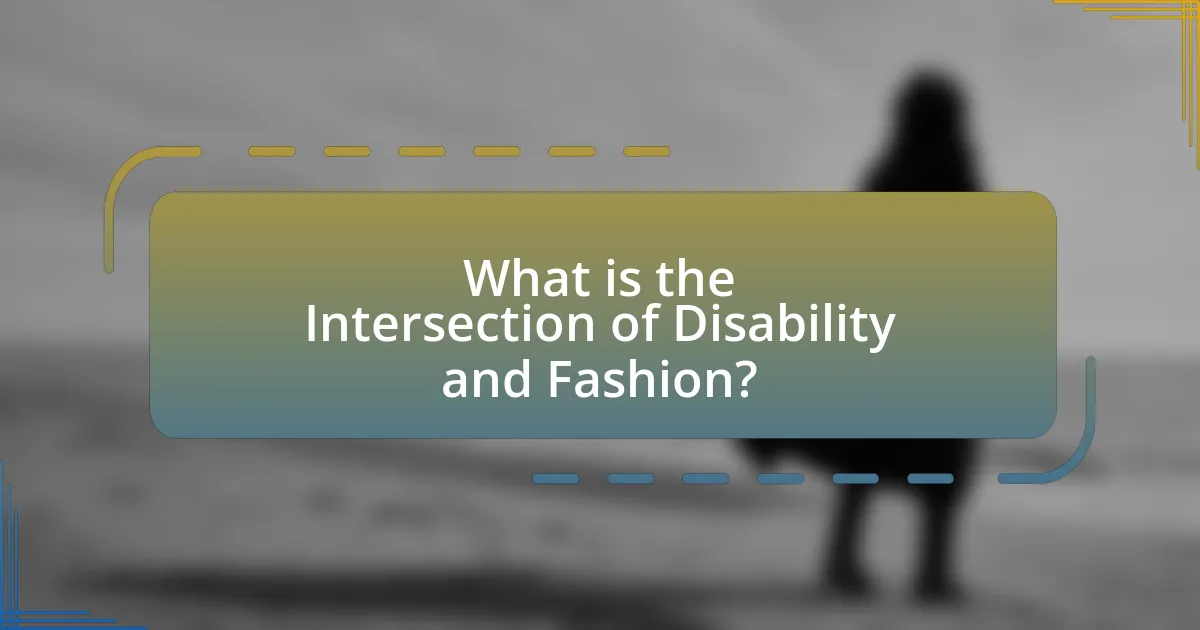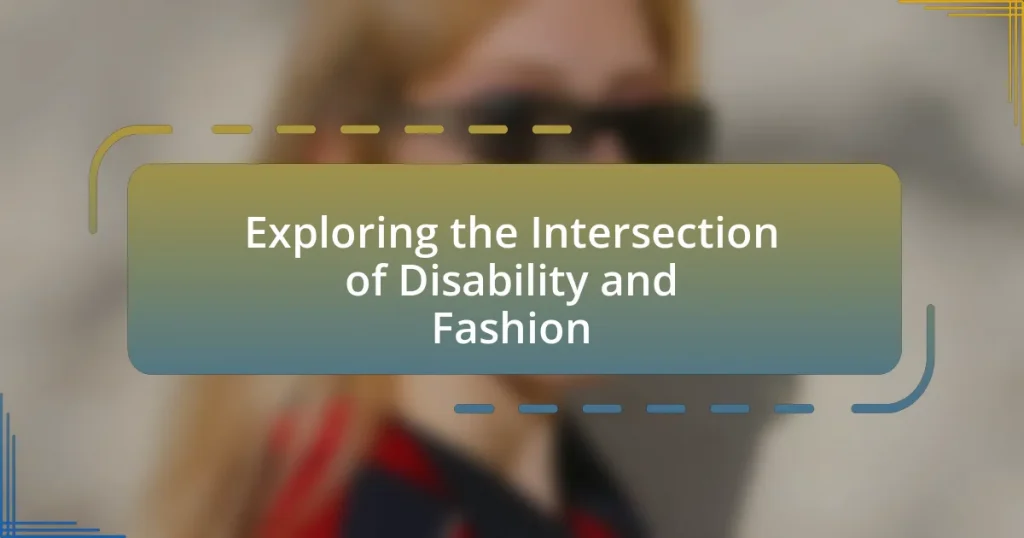The article explores the intersection of disability and fashion, highlighting how the fashion industry is increasingly addressing the needs and representation of individuals with disabilities. It discusses the significance of adaptive clothing lines from brands like Tommy Hilfiger and Nike, which cater to diverse body types and mobility challenges. Key topics include the specific needs of individuals with disabilities in fashion, the importance of representation, the challenges designers face, and the role of technology in enhancing inclusive design. The article also examines consumer demand for adaptive fashion and the future prospects for inclusivity in the industry.

What is the Intersection of Disability and Fashion?
The intersection of disability and fashion refers to the ways in which the fashion industry addresses the needs and representation of individuals with disabilities. This intersection is increasingly recognized as essential for promoting inclusivity and accessibility in clothing design, marketing, and retail experiences. For instance, brands like Tommy Hilfiger and Nike have developed adaptive clothing lines that cater specifically to people with disabilities, demonstrating a commitment to inclusivity. Research indicates that approximately 15% of the global population lives with some form of disability, highlighting the significant market potential for adaptive fashion. This growing awareness is reshaping industry standards and encouraging designers to create functional yet stylish clothing that accommodates diverse body types and mobility challenges.
How does disability influence fashion choices?
Disability significantly influences fashion choices by necessitating adaptations in clothing design and functionality. Individuals with disabilities often require garments that accommodate mobility aids, such as wheelchairs or prosthetics, leading to the demand for inclusive fashion that prioritizes comfort and accessibility. For instance, brands like Tommy Hilfiger and Zappos have developed adaptive clothing lines that feature adjustable closures and easy-to-wear designs, reflecting the need for practicality without sacrificing style. This shift in fashion not only addresses the physical needs of individuals with disabilities but also promotes a more inclusive representation in the fashion industry, as evidenced by the increasing visibility of models with disabilities on runways and in advertising campaigns.
What specific needs do individuals with disabilities have in fashion?
Individuals with disabilities have specific needs in fashion that focus on accessibility, comfort, and functionality. Accessible clothing often includes features such as adaptive designs, which allow for easier dressing and undressing, like magnetic closures instead of buttons or zippers. Comfort is crucial, as individuals may require softer fabrics and tagless designs to avoid irritation. Additionally, functionality is important; clothing may need to accommodate medical devices or provide ease of movement for those with mobility challenges. Research indicates that 1 in 5 people in the U.S. live with a disability, highlighting the significant market demand for inclusive fashion solutions.
How do these needs shape the design of clothing?
The needs of individuals with disabilities significantly shape the design of clothing by prioritizing functionality, accessibility, and comfort. Designers incorporate features such as adaptive fastenings, adjustable sizes, and sensory-friendly materials to accommodate various physical and sensory requirements. For instance, brands like Tommy Hilfiger and Zappos have developed lines specifically for people with disabilities, demonstrating a market demand for inclusive fashion. This approach not only enhances usability but also promotes independence and dignity for wearers, aligning with the broader movement towards inclusivity in the fashion industry.
Why is representation important in the fashion industry?
Representation is important in the fashion industry because it fosters inclusivity and reflects the diversity of society. When fashion brands showcase models of various abilities, sizes, ethnicities, and genders, they challenge traditional beauty standards and promote acceptance. Research indicates that diverse representation can lead to increased consumer engagement; for instance, a study by the Geena Davis Institute on Gender in Media found that inclusive advertising can enhance brand loyalty and sales. By prioritizing representation, the fashion industry not only empowers marginalized groups but also drives innovation and creativity, ultimately benefiting the entire market.
How does representation affect the perception of disability in society?
Representation significantly influences the perception of disability in society by shaping narratives and attitudes towards individuals with disabilities. When media and fashion industries include diverse representations of disabled individuals, it challenges stereotypes and promotes understanding, leading to greater acceptance. For instance, a study by the University of Southern California found that positive portrayals of disabled characters in film and television can reduce stigma and foster empathy among viewers. This indicates that increased visibility and accurate representation can transform societal perceptions, encouraging inclusivity and respect for people with disabilities.
What role do models with disabilities play in fashion campaigns?
Models with disabilities play a crucial role in fashion campaigns by promoting inclusivity and challenging traditional beauty standards. Their presence in advertising helps to raise awareness about the diversity of body types and abilities, fostering a more representative industry. Research indicates that brands featuring models with disabilities can enhance consumer perception and loyalty, as seen in campaigns by companies like Aerie and Savage X Fenty, which have successfully integrated models with disabilities into their marketing strategies. This approach not only reflects societal changes towards acceptance and representation but also drives sales, as consumers increasingly seek brands that align with their values of inclusivity.
What challenges do designers face when creating inclusive fashion?
Designers face several challenges when creating inclusive fashion, primarily related to understanding diverse body types and functional needs. The complexity of accommodating various disabilities requires designers to balance aesthetics with practicality, often leading to limited options that do not fully meet the needs of all consumers. Additionally, there is a lack of industry standards and guidelines for inclusive design, which can result in inconsistent quality and fit across different brands. Research indicates that only 1% of fashion brands prioritize inclusivity, highlighting a significant gap in the market and a lack of awareness among designers about the importance of representation. This gap can hinder the development of innovative solutions that cater to the diverse needs of individuals with disabilities.
How do materials and technology impact inclusive design?
Materials and technology significantly enhance inclusive design by enabling the creation of products that accommodate diverse needs and preferences. Advanced materials, such as stretchable fabrics and adaptive fasteners, allow for clothing that fits various body types and mobility challenges, promoting comfort and accessibility. Technology, including 3D printing and smart textiles, facilitates customization and functionality, ensuring that designs can be tailored to individual requirements. For instance, a study by the University of Southern California found that the integration of wearable technology in clothing can provide real-time health monitoring for individuals with disabilities, demonstrating how technological advancements can directly improve the usability of fashion for all.
What are the common misconceptions about designing for disabilities?
Common misconceptions about designing for disabilities include the belief that such designs are solely functional, lack aesthetic appeal, and cater only to physical disabilities. Many assume that accessibility compromises style, but research shows that inclusive design can enhance both functionality and aesthetics, as seen in brands like Nike and Tommy Hilfiger, which have successfully integrated stylish adaptive clothing into their collections. Additionally, the notion that disability design only addresses mobility issues overlooks the diverse needs of individuals with sensory, cognitive, and mental health challenges, emphasizing the importance of a holistic approach in design.

How is the fashion industry evolving to accommodate disabilities?
The fashion industry is evolving to accommodate disabilities by increasingly prioritizing inclusivity through adaptive clothing lines and innovative design practices. Brands such as Tommy Hilfiger and Zappos have launched collections specifically designed for individuals with disabilities, featuring adjustable fastenings, sensory-friendly fabrics, and wheelchair-friendly designs. Research indicates that approximately 1 in 5 people in the U.S. live with a disability, highlighting a significant market demand for accessible fashion. Additionally, initiatives like the Adaptive Fashion Show at New York Fashion Week showcase the importance of representation and diversity in the industry, further driving the evolution towards inclusivity.
What initiatives are being taken by fashion brands?
Fashion brands are increasingly implementing initiatives to enhance inclusivity for individuals with disabilities. For instance, brands like Tommy Hilfiger and Nike have launched adaptive clothing lines designed specifically for people with varying physical needs, featuring modifications such as magnetic closures and adjustable fits. Additionally, the Council of Fashion Designers of America (CFDA) has introduced programs to promote accessibility in fashion shows and events, ensuring that models with disabilities are represented on the runway. These initiatives reflect a growing recognition of the importance of inclusivity in the fashion industry, aiming to create a more equitable environment for all consumers.
Which brands are leading the way in adaptive fashion?
Brands leading the way in adaptive fashion include Tommy Hilfiger, Nike, and Zappos. Tommy Hilfiger launched its adaptive clothing line in 2016, designed specifically for individuals with disabilities, featuring adjustable hems and magnetic closures. Nike introduced the FlyEase shoe line, which offers easy entry and exit for those with mobility challenges. Zappos has a dedicated section for adaptive footwear, showcasing various brands that cater to the needs of individuals with disabilities. These brands are recognized for their commitment to inclusivity and innovation in fashion.
How are collaborations with disability advocates shaping fashion trends?
Collaborations with disability advocates are significantly shaping fashion trends by promoting inclusivity and accessibility in design. These partnerships lead to the creation of adaptive clothing lines that cater to the needs of individuals with disabilities, thereby challenging traditional fashion norms. For instance, brands like Tommy Hilfiger and Nike have launched adaptive collections that feature adjustable fits and easy closures, demonstrating a commitment to inclusivity. Research indicates that the global adaptive clothing market is projected to reach $400 billion by 2026, highlighting the growing demand for fashion that accommodates diverse body types and abilities. This shift not only enhances representation in the fashion industry but also encourages other brands to prioritize inclusivity in their designs.
How does consumer demand influence adaptive fashion?
Consumer demand significantly influences adaptive fashion by driving brands to create more inclusive and functional clothing options for individuals with disabilities. As consumers increasingly seek stylish yet practical garments that accommodate various needs, fashion companies respond by innovating designs that prioritize accessibility, comfort, and aesthetics. For instance, a 2021 report by the Global Disability Inclusion found that 70% of consumers are more likely to purchase from brands that offer adaptive clothing, highlighting the market potential for businesses that cater to this demographic. This shift in consumer preferences not only encourages the expansion of adaptive fashion lines but also fosters greater awareness and acceptance of disability within the fashion industry.
What are the trends in consumer preferences regarding inclusive clothing?
Consumer preferences regarding inclusive clothing are increasingly leaning towards functionality, diversity, and sustainability. Research indicates that 70% of consumers prefer brands that offer adaptive clothing options, highlighting a growing demand for garments that cater to various body types and abilities. Additionally, there is a notable trend towards brands that prioritize sustainable materials and ethical production practices, with 54% of consumers willing to pay more for eco-friendly clothing. This shift reflects a broader societal movement towards inclusivity and environmental responsibility in fashion.
How can feedback from the disability community improve fashion offerings?
Feedback from the disability community can significantly enhance fashion offerings by ensuring that designs are inclusive and functional. When fashion brands actively seek input from individuals with disabilities, they can identify specific needs such as adaptive clothing features, accessibility in fit, and the use of materials that accommodate various physical requirements. For instance, brands like Tommy Hilfiger and Zappos have successfully integrated feedback from the disability community, leading to the creation of adaptive clothing lines that cater to diverse needs. This approach not only broadens the market reach but also fosters a sense of belonging and representation for individuals with disabilities in the fashion industry.

What are the future prospects for disability in fashion?
The future prospects for disability in fashion are increasingly positive, driven by a growing awareness and demand for inclusivity. Major fashion brands are beginning to recognize the importance of adaptive clothing, which caters to individuals with disabilities, as evidenced by initiatives from companies like Tommy Hilfiger and Nike, who have launched lines specifically designed for accessibility. Additionally, the rise of social media platforms has empowered disabled individuals to advocate for representation and visibility in fashion, leading to collaborations with designers and increased media coverage. Research indicates that the global adaptive clothing market is projected to reach $400 billion by 2026, highlighting the economic potential and consumer interest in this sector.
How can technology enhance fashion for individuals with disabilities?
Technology can enhance fashion for individuals with disabilities by providing adaptive clothing solutions that improve accessibility and comfort. Innovations such as 3D printing allow for custom-fit garments tailored to specific physical needs, while smart textiles can incorporate features like temperature regulation and moisture-wicking properties. Additionally, wearable technology, such as garments with built-in sensors, can assist individuals with mobility challenges by offering support or alerts for health monitoring. Research indicates that the adaptive clothing market is growing, with a projected value of $400 billion by 2025, reflecting the increasing demand for inclusive fashion solutions.
What innovations are currently being explored in adaptive clothing?
Innovations currently being explored in adaptive clothing include the use of smart textiles, adjustable features, and inclusive design principles. Smart textiles incorporate technology such as sensors and heating elements to enhance functionality for individuals with disabilities. Adjustable features, like magnetic closures and elastic materials, facilitate easier dressing for those with limited mobility. Inclusive design principles ensure that clothing is not only functional but also aesthetically appealing, catering to diverse body types and personal styles. Research indicates that these innovations aim to improve independence and comfort for wearers, reflecting a growing recognition of the importance of adaptive fashion in enhancing quality of life.
How can 3D printing and smart textiles revolutionize inclusive fashion?
3D printing and smart textiles can revolutionize inclusive fashion by enabling the creation of customized clothing that meets the specific needs of individuals with disabilities. This technology allows for the production of garments tailored to unique body shapes and mobility requirements, enhancing comfort and functionality. For instance, 3D printing can produce adaptive clothing with features like magnetic closures or adjustable fits, which are essential for individuals with limited dexterity. Additionally, smart textiles can incorporate sensors that monitor health conditions or adjust temperature, further improving the wearer’s experience. Research indicates that the global adaptive clothing market is projected to reach $400 billion by 2026, highlighting the growing demand for inclusive fashion solutions.
What role does education play in promoting inclusive fashion design?
Education plays a crucial role in promoting inclusive fashion design by equipping designers with the knowledge and skills necessary to create accessible and adaptive clothing. Through specialized curricula that focus on the needs of individuals with disabilities, educational programs foster an understanding of diverse body types, functional requirements, and the importance of representation in fashion. For instance, institutions like the Fashion Institute of Technology offer courses that emphasize inclusivity, enabling students to design garments that cater to a wider audience. This educational foundation not only enhances creativity but also encourages future designers to prioritize inclusivity as a fundamental aspect of their work, ultimately leading to a more equitable fashion industry.
How can fashion schools incorporate disability awareness into their curriculum?
Fashion schools can incorporate disability awareness into their curriculum by integrating courses that focus on adaptive design and inclusive practices. This approach can include workshops that teach students how to create clothing that accommodates various disabilities, ensuring that all individuals have access to fashionable options. Research indicates that approximately 15% of the global population lives with some form of disability, highlighting the necessity for inclusive design in fashion. By collaborating with disability advocacy groups and involving individuals with disabilities in the design process, fashion schools can provide students with firsthand insights and experiences, fostering a more comprehensive understanding of the needs and preferences of diverse consumers.
What resources are available for aspiring designers focused on inclusivity?
Aspiring designers focused on inclusivity can access various resources, including online courses, design communities, and literature. Platforms like Coursera and Skillshare offer courses specifically on inclusive design principles, while organizations such as the Inclusive Design Research Centre provide guidelines and case studies. Additionally, books like “Designing for Diversity” by Jennifer D. Pahlka and “Inclusive Design: A Universal Approach” by David A. G. Smith serve as valuable references. These resources collectively equip designers with the knowledge and tools necessary to create inclusive fashion solutions.
What practical tips can consumers consider when choosing adaptive fashion?
Consumers should prioritize comfort, functionality, and style when choosing adaptive fashion. Comfort is essential, as adaptive clothing often needs to accommodate specific physical needs, such as ease of dressing or mobility. Functionality is crucial; look for features like adjustable closures, stretchable fabrics, and easy access points that facilitate dressing for individuals with disabilities. Style should not be overlooked; adaptive fashion should reflect personal taste and current trends to promote confidence and self-expression. Research indicates that inclusive design in fashion can enhance the quality of life for individuals with disabilities, making these considerations vital for consumers.














